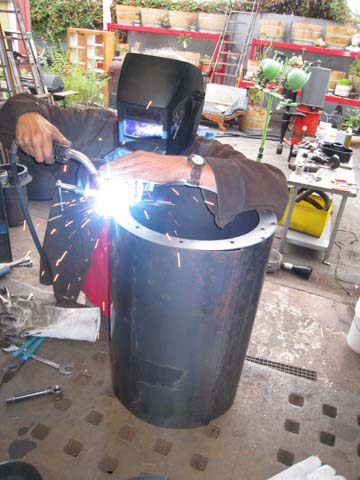The GEKOpalyn welds up the Gasifier's Experimenter's KitRobert Heinlein, in The Moon is a Harsh Mistress suggests that when a problem is too big, break it down into smaller pieces that can each be deciphered. The production of a liquid fuel from synthesis gas is one such problem. In an effort to work on one of those smaller pieces of the biomass to methanol project, I decided to learn more about Jim Mason's Gasification Experimenter's Kit aka the "GEK." Jim Mason at All Power Labs has been working on standardizing gasification reactors so that many people using the same system can compare results using different fuel sources and providing burnable gasses to different engines. We decided that a road trip to All Power Labs was in order. This trip would provide me with the time and resources to assemble my own GEK. One of the first things we did upon our arrival was to fire off the #2 reactor. It was great to see the finished product in action before I started assembling my unit.
All Power Labs uses a computer-controlled plasma torch to cut sheet steel into the various pieces of the GEK. Here is the plasma torch in action cutting out pieces for Mutopia. Mutopia will be presented at this fall's Burning Man event by the Flaming Lotus Girls.
The first piece to be assembled was the gas cowling. It consists of two different rings and a square piece rolled into a tube. The rings were welded to the top and bottom of the tube and in about an hour the first piece had come together. With the completion of an ash grate and attachment of various plumbing parts like couplings and threaded pipe the cowling was complete.
The next piece to be welded together was the reactor unit which fits inside the cowling. This piece was more involved and included four rings and two tubes plus about a dozen smaller parts to be welded in place.
The completed reactor (shown upside-down) slides right inside the gas cowling. The flexible stainless steel hoses work as a heat exchanger that cools the gaseous fuel by heating the incoming air on its way into the center of the reactor.
Inside the reactor: these pipes and nozzles bring atmospheric oxygen pre-heated by the stainless steel hoses into the reaction zone. This is where the pyrolysis occurs.
Welding the rings onto this tube creates the hopper allowing the GEK to run longer between refilling the woody biomass. The hopper can be bolted to the reactor.
Here is the combined cyclone and filter unit.
The gaseous fuel exits the gas cowling and enters the cyclone (at about knee height in the photo) swirling around and allowing particles to drop out while the gas moves up through the steel wool filtration unit. A paddle fan and motor can be placed on top creating a vacuum drawing the various gasses through the system. The hose lying on the ground is used to transport the gas to the engine or burner. Next steps include painting the GEK to prevent corrosion, packing the reactor with insulation and char, then firing it off and testing different woody fuels. |







